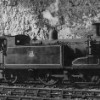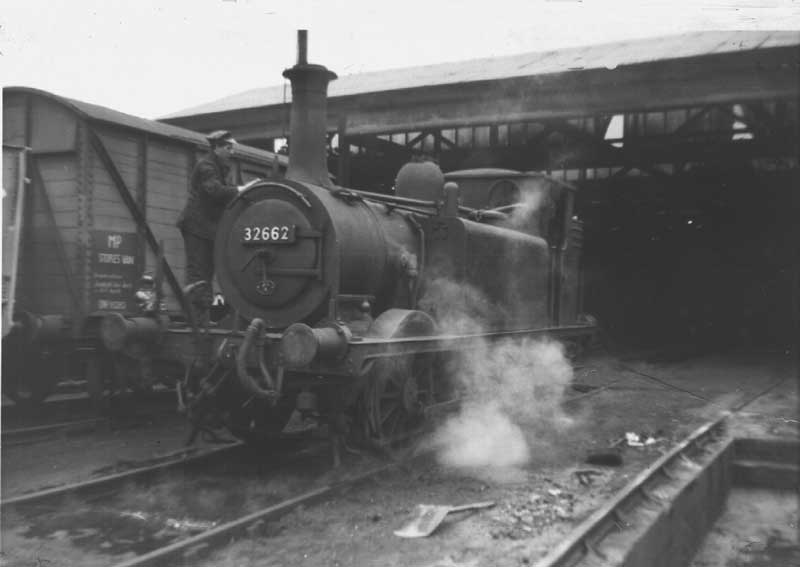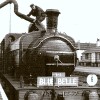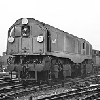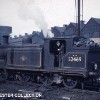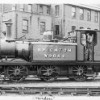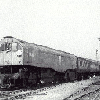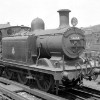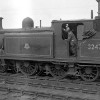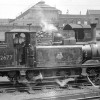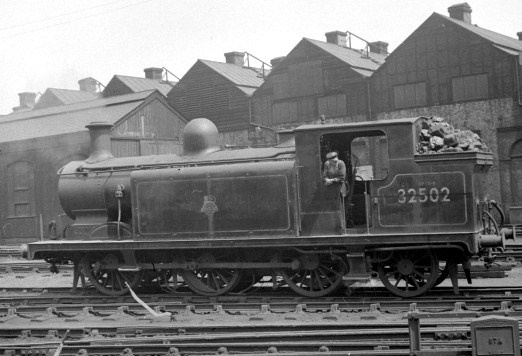THE BRIGHTON MOTIVE POWER DEPOTS WEBSITE.
HAS NOW BEEN MOVED TO A NEW SITE CALLED
IGNITING THE FLAMING OF UNITY
https://ignitingtheflameofunity.yolasite.com/
PLEASE CLICK ON THE IMAGE BELOW
TO TRANSFER TO THIS NEW SITE
CLICK ON THE ABOVE IMAGE TO TAKE YOU
TO THE NEW UPDATED COMBINED AND WEBSITE
IGNITING THE FLAME OF UNITY WEBSITE
https://ignitingtheflameofunity.yolasite.com/
THIS WEBSITE COMBINES THE FOLLOWING WEBSITES
THE BRIGHTON A.S.L.E.&F., THE BRIGHTON MOTIVE POWER DEPOTS
& THE SUSSEX MOTIVE POWER WEBSITES
WHICH EXPLAINS THE EVOLUTION OF THE FOOTPLATE GRADES AND THE
HISTORY OF THEIR TRADE UNIONS AND THE STRUGGLES TO IMPROVE
THEIR WORKING LIVES
CLICK ON THE ABOVE IMAGE TO TAKE YOU
TO THE NEW UPDATED COMBINED AND WEBSITE
IGNITING THE FLAME OF UNITY WEBSITE
https://ignitingtheflameofunity.yolasite.com/
THIS WEBSITE COMBINES THE FOLLOWING WEBSITES
THE BRIGHTON A.S.L.E.&F., THE BRIGHTON MOTIVE POWER DEPOTS
& THE SUSSEX MOTIVE POWER WEBSITES
WHICH EXPLAINS THE EVOLUTION OF THE FOOTPLATE GRADES AND THE
HISTORY OF THEIR TRADE UNIONS AND THE STRUGGLES TO IMPROVE
THEIR WORKING LIVES
BRIGHTON LOCOMOTIVE DEPOT
1840 ~ 1964

There may be some loco-men featured on this page that were not A.S.L.E.F. members.
Some of the Brighton loco-men belonged to an alternative railway trade unions, such as the A.S.R.S./N.U.R., whilst others remained non trade unionist. These men always enjoyed the benefits that where gained on the backs of A.S.L.E.F. members, who made their own personal scarifies in the aim of trying to improve their working lives.
A scene in Brighton Loco during the Southern Railway era. Any ideas on the Loco-men featured
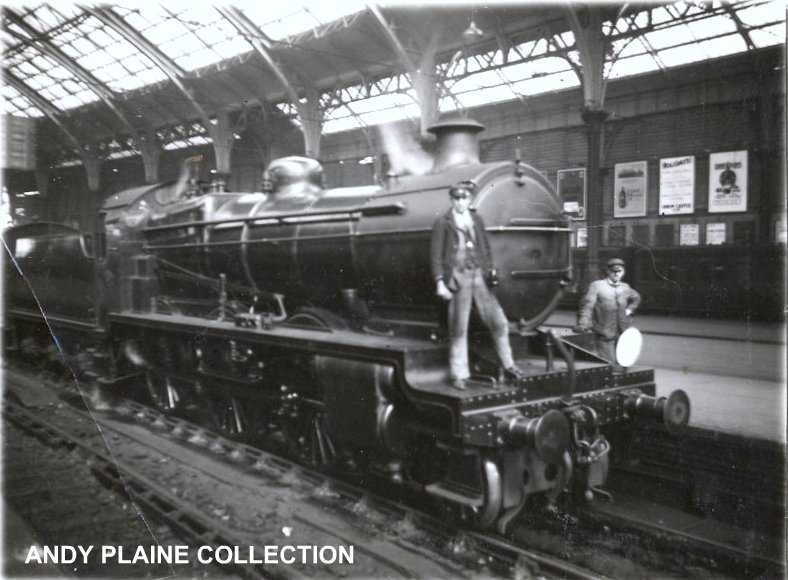
William Plaine standing on the front of the locomotive in Brighton station.
My grandfather, William Plaine, spent his entire career on the footplate of a locomotive on the London to Brighton line. circa 1915 to 1960. He started off shoveling coal and progressed through to become an engine driver.
I believe that is William Plaine standing on the front of the locomotive in Brighton station. I have included another picture of him (Right). in case somebody might have other photos and might recognise him.
I looking through your site I saw pictures of Phil Plaine who is probably a relative of ours. My Dad told me before he passed (1990) that several of my granddad's cousins were on the railway (one was Henry Plaine, I believe). My brother has a photo taken in the early 1930's of a social outing (charabang trip) showing the footplatemen having a pint. I will see if I can get a copy of that for you. By the way, my grandad lived on Milner Road in Brighton. His wife was Ada.
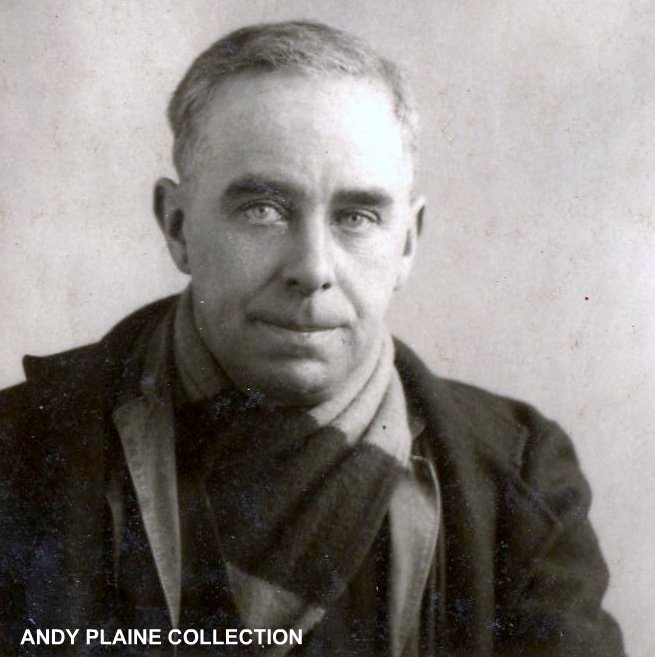
William Plaine
William Charles Plaine was one of many members of the Plaine Family who worked on the railway within the Brighton area.
William had a brother Walter (who entered the footplate grades on 29.04.1901) where also a on the footplate at Brighton. William's nephew Phil Plaine (Walters son ) entered the fooplate grades in 11.10.1943.
William entered the footplate grades on 26.10.1914 and later transferred to either West Worthing or Brighton motorman's depot in 1949. The Brighton No.2 subscriptions Branch book, shows a W.C. Plaine first pay his first contribution in the March quarter of 1949. There is no clear indication of which of the two depots he was at, and there is also no mentioned of his previous branch/depot proir to his transfer to Brighton No.2, which was quite often recorded in this ledger. It is thought that he had transferred from the Brighton steam depot (ASLEF B'ton No. 1 Branch).
William remained a member of Brighton No.2 until his retirement in 1962. The last ASLEF contribution was made in the June quarter of 1962 and he therefore retired shortly after this date.
William Charles was the Brighton No.1 Branch Secretary during the period of 1937- 41
Other members of the Plaine family worked on the footplate are
A. Plaine footplate seniority 23.5.1898
(left the footplate and transferred to the C.M.E. Department according to the Southern Railway magazine in Jan/Feb1942 page 26)
George E. Plaine footplate seniority 31.8.1917
I am trying to find out which members of the Plaine family were known as TROCCO PLAINE'Trocco' Plaine Snr received this nickname because when he first started at Brighton as an engine cleaner, he was a regular engine cleaner on Stoudley's E-tank No. 118 'Trocadero'. When his son started at Brighton as an engine cleaner, he too was known as 'Trocco'. By this time 'Trocco' Snr was already a driver at Brighton.
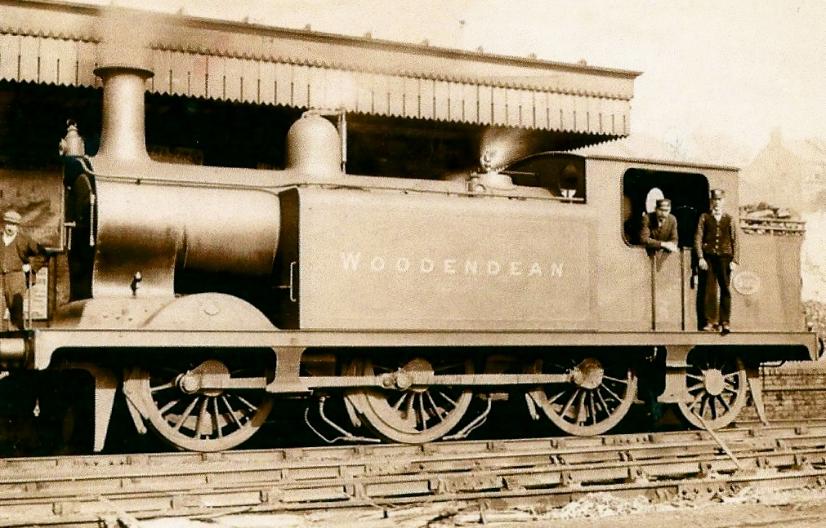
GRAHAM FINLEY COLLECTION
Brighton Driver Harry “The Captain” Finley, with his son Reginal Albert Taylor.
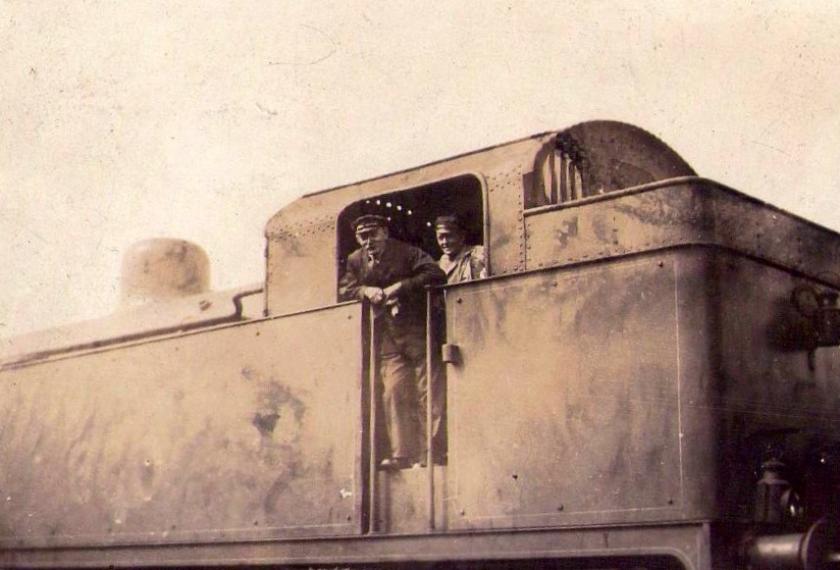
GRAHAM FINLEY COLLECTION
Brighton Driver Harry “The Captain” Finley, with Horace Raymond Taylor
PETER GAMBLING COLLECTION
DRIVER FRED 'RAB' GAMBLING & FIREMAN KEN STEER
In Sailsbury Loco on Saturday 13th September 1958, before leaving to work the 2.53 p.m. back to Brighton, with 399 tons 'all the way'
Photo and words by Fred Rich
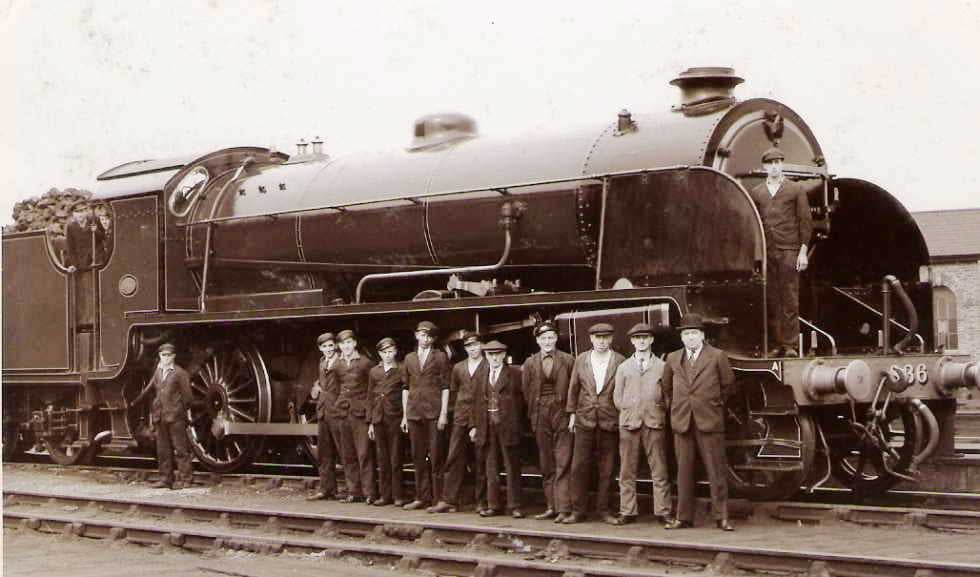
STORIES FROM THE SHOVEL
Driver George Laycock
George Laycock was one of my favourite drivers out of the 11 regular mates during his firing career. I
fired to George in 1949-1950 in the next to top link, without doubt
the happiest two years of my firing career. He had the nickname of John
Bull and a couple of his previous mates didn't get on too well with him
but we got on well together and would frequently have a drink and game of snooker even though we had done a days work together
I can recall, that all my drivers were very nice blokes and it was a pleasure to be at work with them all. However George really stands out from the rest.
I fired to George in the "Second Gang" which at time was mostly made up of work which the "Top Gang" did not want, so the "Second Gang" had a variety of work which included a trip up the "Cuckoo" from Polegate to the Wells along with the 03:25 paper train.
He had a wicked side and Tunbridge Wells was his happy hunting ground for winding people up, more often than not about their short shunts to London and what they were missing by not having West Country's to work on.
George or Gerry as he was often known, was the tops!
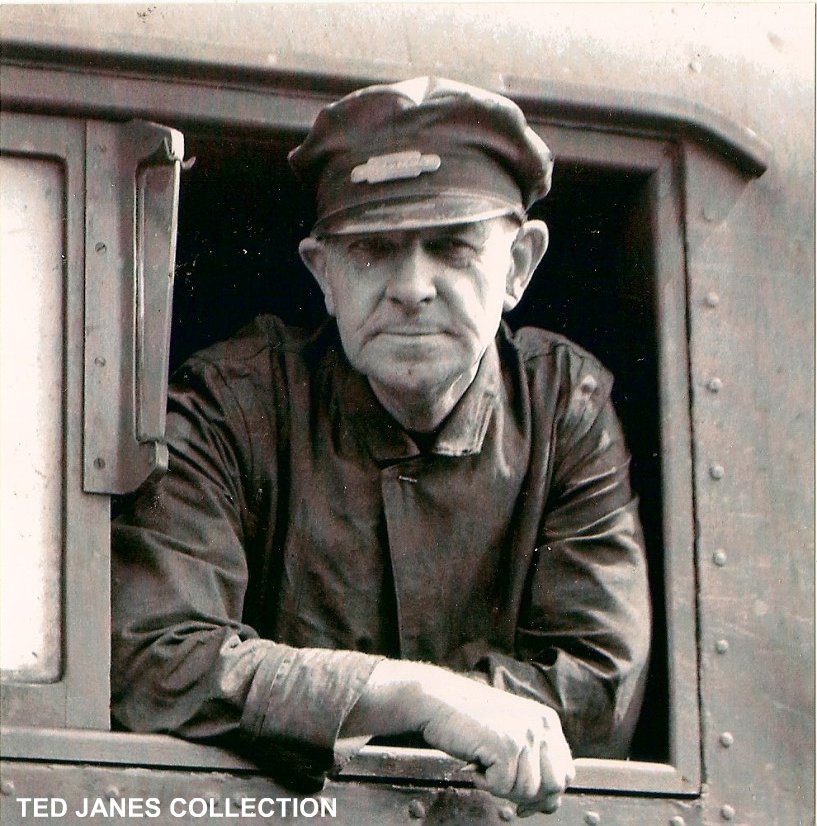
Driver George Frederick Laycock on BR 4 Tank 80019 on the 20th June 1952
Both photos of George were taken by Fred Rich
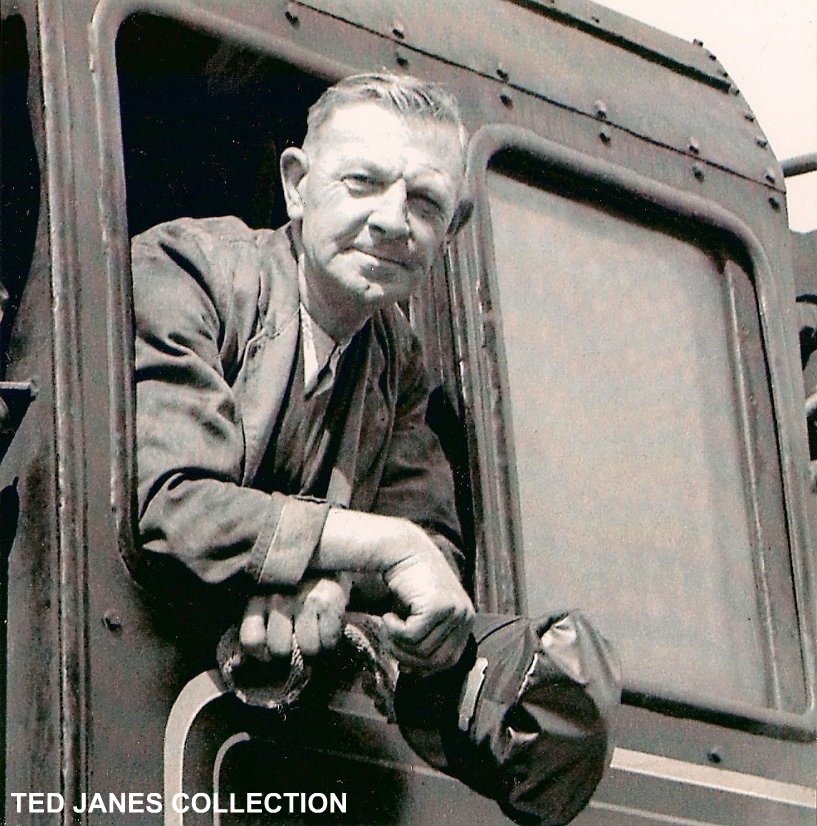
Driver George Frederick Laycock on a West Country 34045 "Ottery St. Mary" on the 4th July 1952
George was approach his 62nd birthday which was on the 23rd July.
George entered the footplate grades on the 11.06.1909.
George Laycock was one of my favourite drivers out of the 11 regular mates during his firing career. I fired to George in 1949-1950 in the next to top link, without doubt the happiest two years of my firing career. He had the nickname of John Bull and a couple of his previous mates didn't get on too well with him but we got on well together and would frequently have a drink and game of snooker even though we had done a days work together
I can recall that all his drivers were very nice blokes and it was a pleasure to be at work with them all. However George really stands out from the rest.
Ted fired to George in the "Second Gang" which at time was mostly made up of work which the "Top Gang" did not want, so the "Second Gang" had a variety of work which included a trip up the "Cuckoo" from Polegate to the Wells along with the 03:25 paper train.
He had a wicked side and Tunbridge Wells was his happy hunting ground for winding people up more often than not about their short shunts to London and what they were missing by not having West Country's to work on.
above Ron French at Guildford
Ron French
Ron French's Fireman Johnny Whiteside
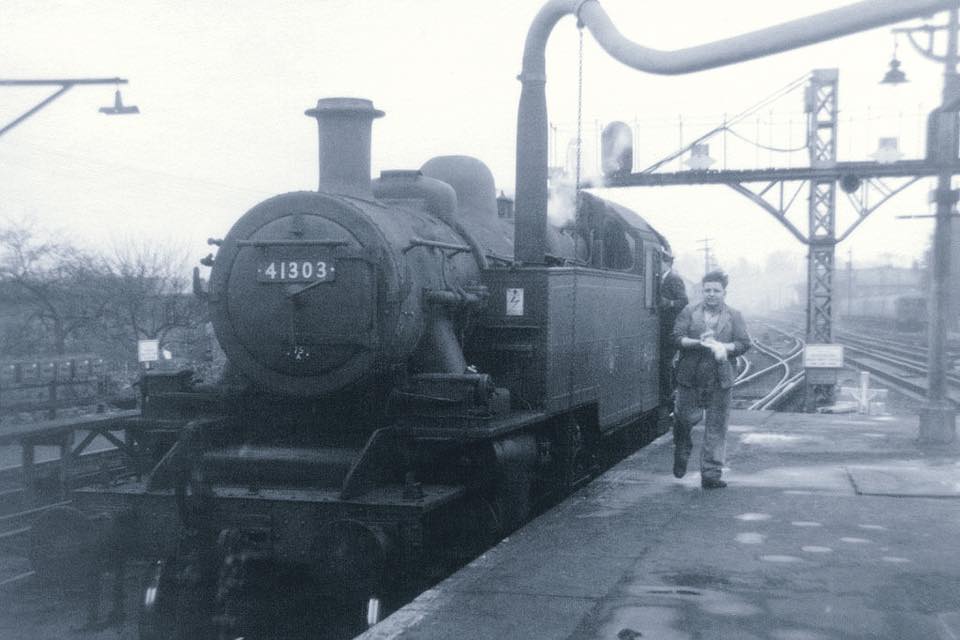
Ron Rabbetts at Horsham
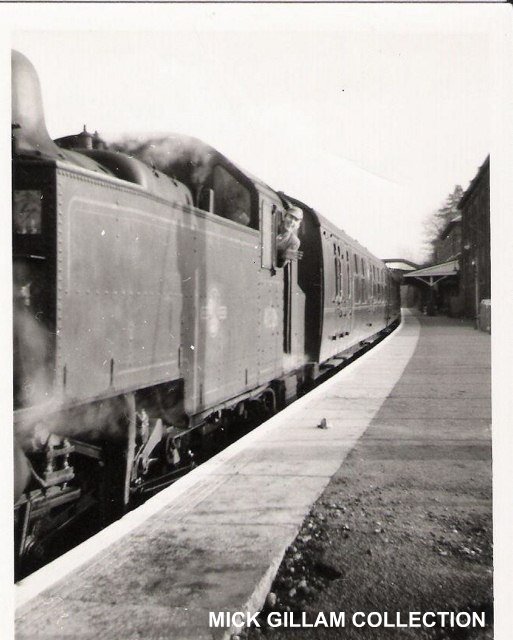
Both photos are of Fireman Mick Gillam and are taken at Steyning the one above in 1963 & below in 1964.
Driver Dave Creasey is just visible behind the water crane.
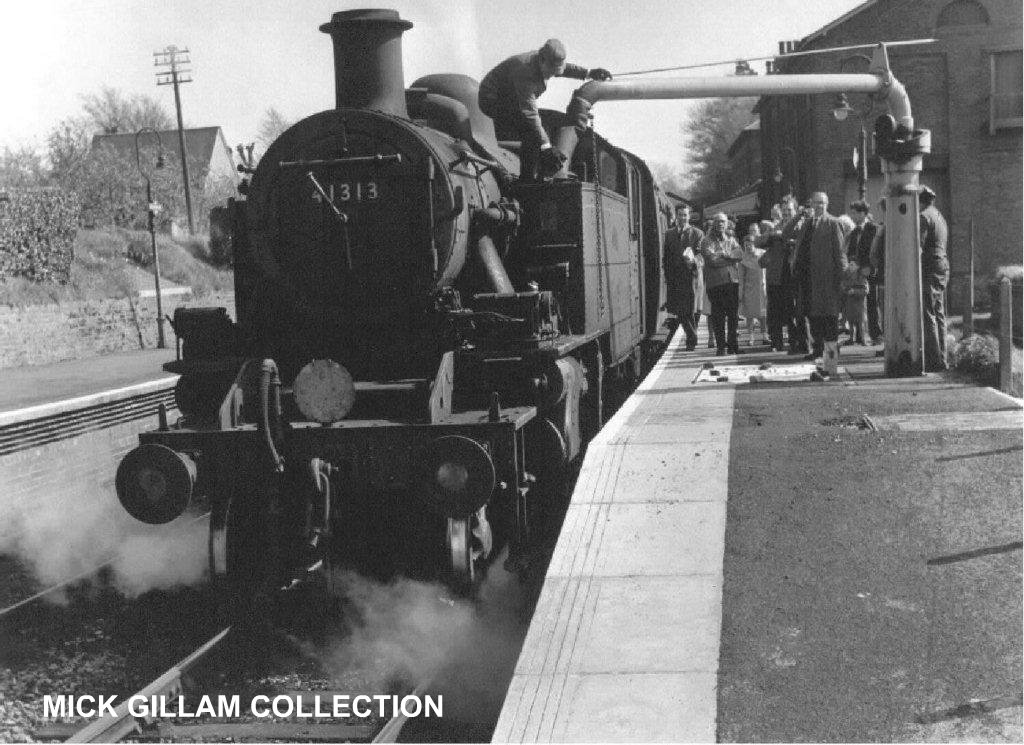
Mick Gillam started at Brighton as a Cleaner boy just after my 16th birthday in 1960 and got his job as a Fireman at Brighton in 1961. Mick transfered to Coulsdon North 1967 to get his promotion to driver and later moved to Littlehampton 1969.
Mick later become a Traction Inspector at Brighton in c1989 finished up at Barnham taking early retirement in 1994.
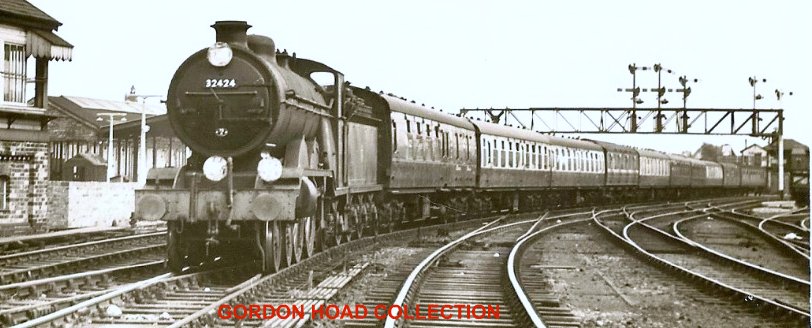
Driver Gordon Hoad
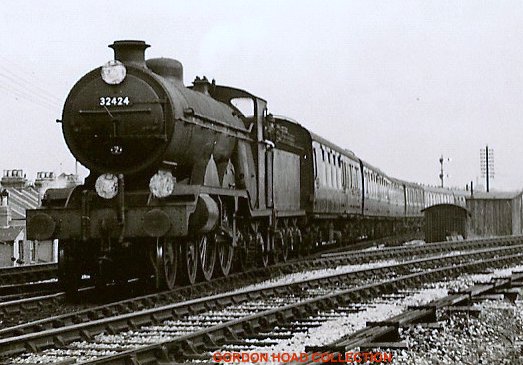
Driver Gordon Hoad at Latchmere Junction working the 12:01 Eastbourne to Manchester service.
Gordon's fireman on this trip was E. Mead.
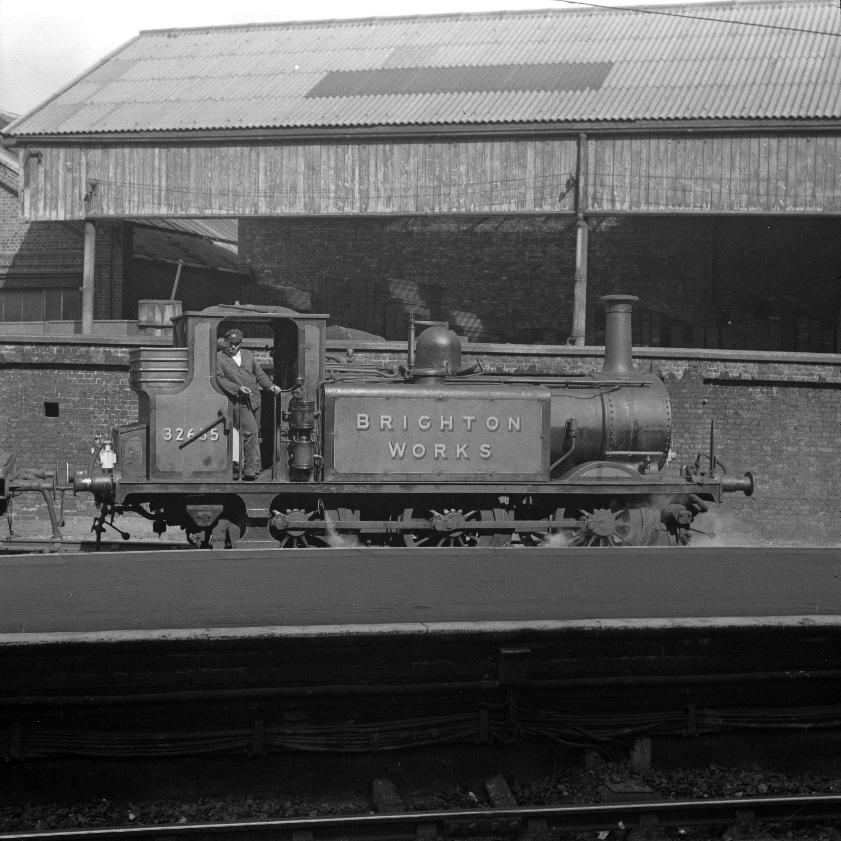
Clifford Highams
Eddie Ricketts
in Chichester Yard with a USA tank engine
Eddie Ricketts Collection
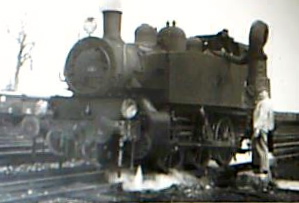
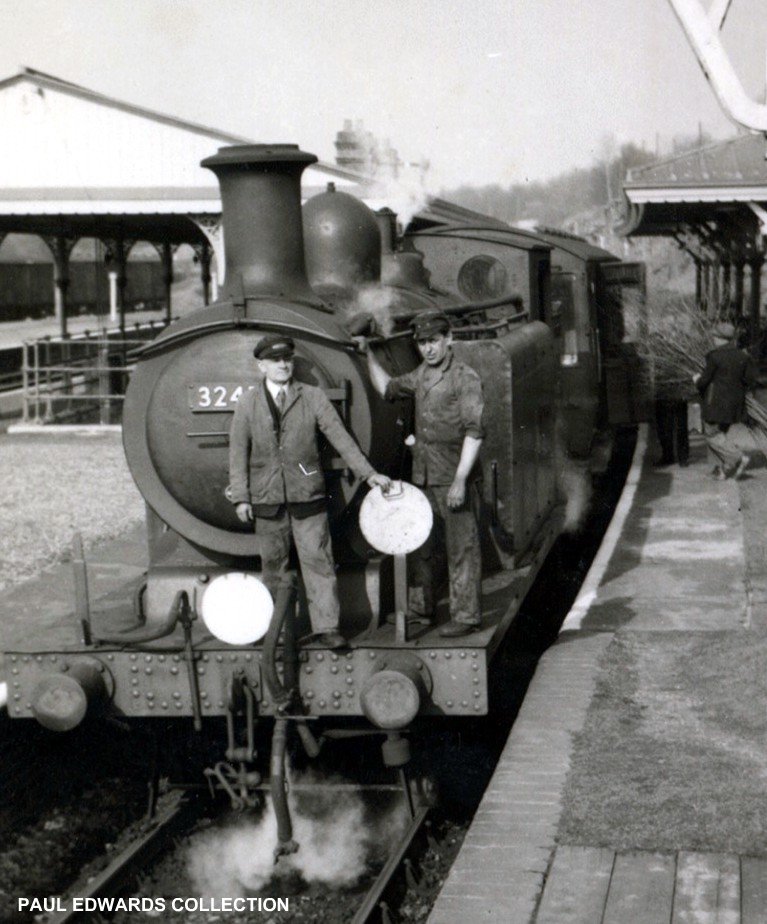
Driver Charlie Thorpe & Fireman Jimmy Edwards at Horsted Keynes on the 14th March 1958,
with the 14:28 down to Lewes
Photo taken Mr. G S Robinson
A rail enthusiast travelled between East Grinstead and Lewes in the final weeks to record the closure of the line in 1955. He then with re-opening in 7th August 1956 and finally come back to record final normal working day on the 14th March 1958. The following day various special trains run over the lines. More photos can be found on the Sussex MPDs web site.
The photo gallery belows shows four photos of Driver Charlie Thorpe & his Fireman Jimmy Edwards
Some of these photos are taken Mr. G S Robinson
Ted Janes remembers Charlie Thorpe. Charlie had been born just before the turn of the century and joined the large number of men returning from the war and coming onto the railway in about 1919 (08.09.1919). Charlie like many of these loco men from that era were very late in passing for driving.
Charlie was a short chap and he could hold his own with anyone in the "Bash'em League" of which there were several members at Brighton.
Ted didn't work with him much, but does remember coming to grief with him on the 3-35pm Oxted to Brighton when they had run out of coal at Lewes and Charlie had decided to chance making it to Brighton, they finally came to a stop (about where Moulsecoomb Station area is these days) absolutely knackered.
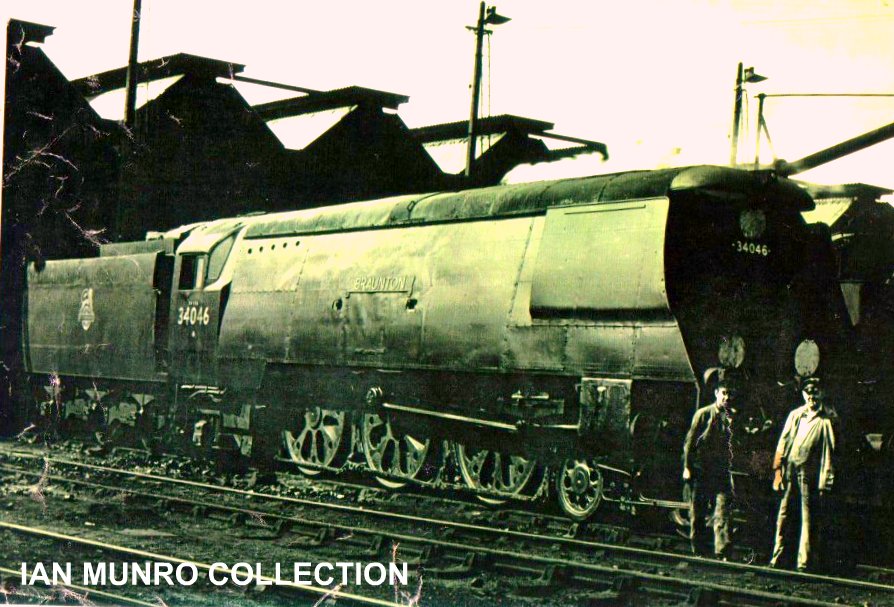
Left ~ Right Fireman Dave Knight & Driver 'Rab' Fred Gambling are standing next to West Country 34046 "BRAUNTON" out side of Salisbury Loco Shed after they had worked a Brighton - Plymouth service.
Fred Gambling entered the footplate grades at Brighton on the 16th August 1912.
Fred received a nickname of 'Rabbit' whilst lodging with Driver Constable (from St. Leonards) at Newhaven during the First World War. Driver Constable, had notice that Fred was all skin and bone and whilst addressing a group of fellow work mates, made a comment about Fred being 'as skinny as blinking rabbit !' This nickname soon got got shorten down to Rab, and with his three sons following in his footsteps onto the footplate at Brighton (Fred, Jimmy & Peter), they too were called referred to as 'Rab'.
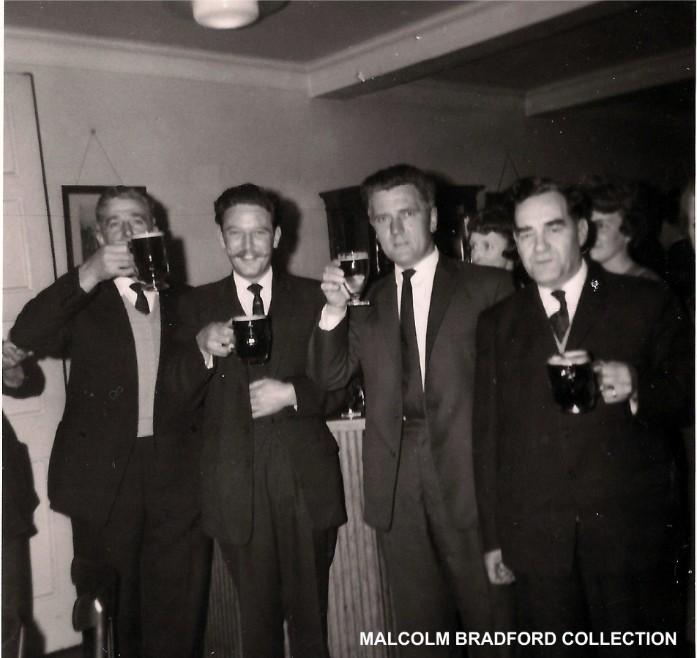
Left ~ Right: Les Bradford, John Norton, Peter Bradford & Unknown
(hopefully some one will let me know who he is)
Peter entered the footplate grade at Brighton loco on the 08.11.1948. Peter spent his entire railway career at Brighton loco/E.M.U.T.
Peter was Brighton No.1 Branch Secretary between 1960 -1966.
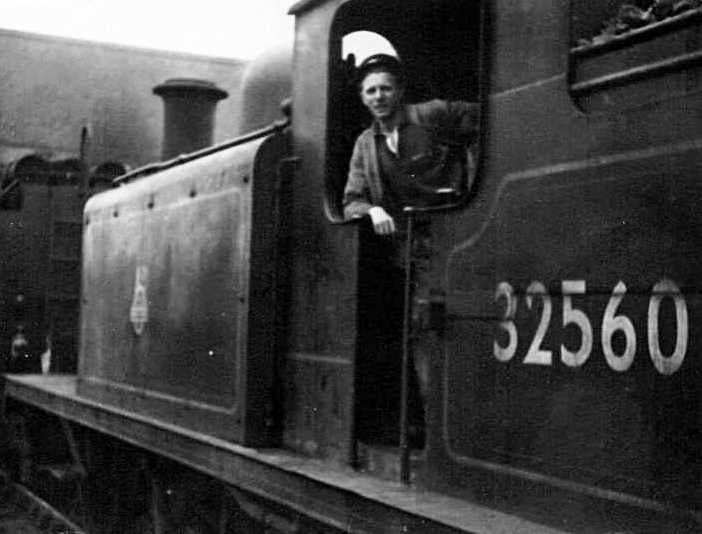
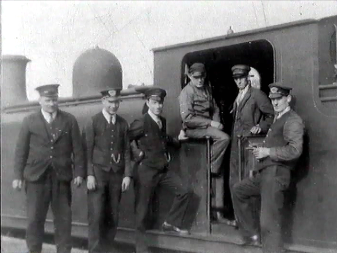
Reg Brooker (Seated)
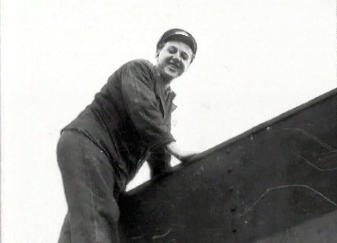
Reg Brooker
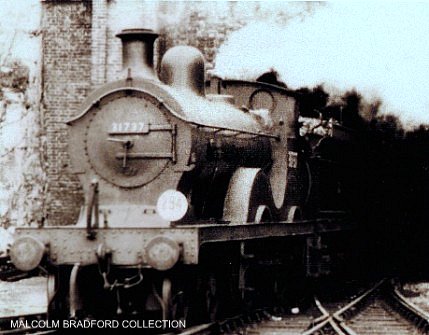
Peter Bradford coming out of the South end of Kemp Town tunnel
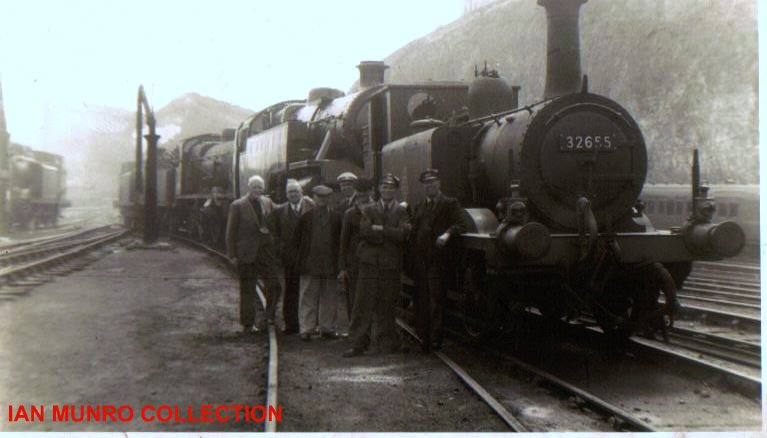
Left ~ Right: Office Gent, Mr. Urrie, Alf Brown (Cleaners Foreman), Unknown, Ian Munro, Bill Terrill (Ron's Father) & Jack Baker (Pasha) c1956
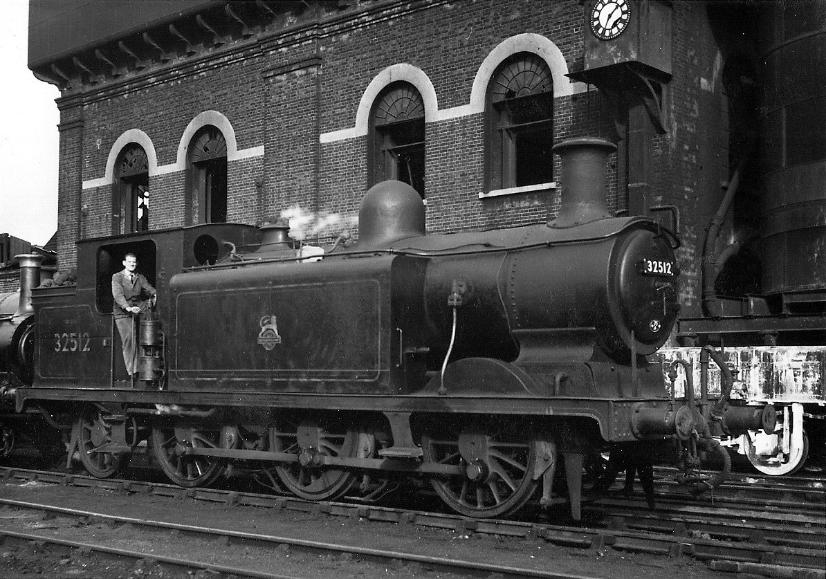
Driver Bill Terrill in Brighton Loco 1965 (Ron's father)
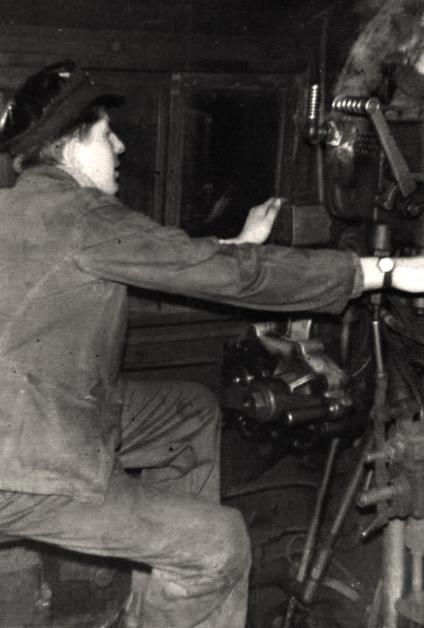
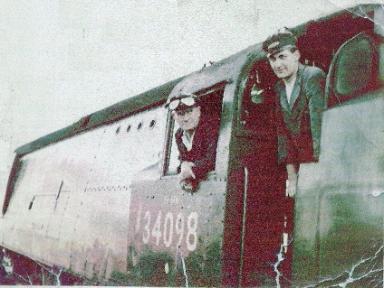
JOE PANNETT COLLECTION
Driver Vic Fewtrell & Fireman Joe Pannett
Are seen working West Country No.34098 "TEMPLECOOMBE" on the 6:10 Victoria to Brighton at Oxted. They had just run fast from East Croydon to Oxted in 16 Mins 7 18 Secs. on the 21st June 1960
TONY SQUIRES COLLECTION
Left
Tony Squires
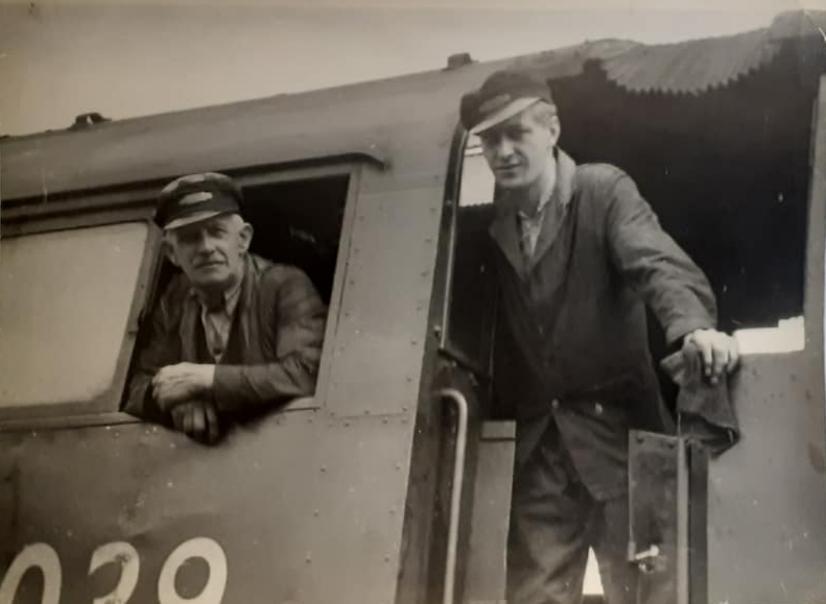
When most of us are preparing for Christmas, Mr. Alf Brooker and his mate, Mr. Frank Heritage, will be on the job, hurtling through the Sussex country side at anything uo to 70 miles an hours. For Mr. Brooker and Mr. Heritage are driver and fireman of one of the Southern Region’s crack West Country class express engines, working long distance expresses out of Brighton.
This week I spent a day with Mr. Brooker and his mate and saw the part they are playing in the Christmas holiday rush. Having done so I can assure all those who might travel this Christmas that if their train is a few minutes late it will not be the driver’s fault.
After pushing my way through the crowd of passengers waiting for the 11o’clock train from Brighton to Cardiff. I clambered aboard the engine which had just backed in from the sheds. Fireman Heritage was coupling up withe the leading coach, while his mate was making a last minute check on the lubricating system.
Driver Broker, who lives at 84 Elm Grove, Brighton, is one of the many veterans who drive Britain’s mainline trains. Joining the old London, Brighton and South Coast Railway in 1907. he has been on the footplate for 40 years: he can remember the days when a driver earned 4s. 3d. per day for anything up to 14 hours’ work, and speak affectionately of many types of engines now out of use.
Fireman Heritage, of 12 Coleman Street, Brighton, is 23, and has been with the railway since 1943.
These two representative of two completely different eras, work in complete harmony, the fireman anticiating the driver’s calls upon the engine by providing the steam required. If it were not so it would mean bad running, with not enough power for the banks and too much pressure at the end of journey.
We’re Off!
As the fingers of station clock drew near to the time of departure, porters fussed around the doors, bags of Christmas mail for South Wales were swung into the brake van, and the platform foreman stood ready to give the all-clear signal.
Home and distant signals were both showing green. Suddenly from the near the barrier there was a flash of green. Driver Brooker eased the regulator open and we were off.
Behind in comfortable, heated compartments, passengers were beginning to open magazines and newspapers, but on the footplate all was activity.
The first shovels-fulls of the two tons of coal used between Brighton and Salisbury were being fed into the hungry mouth of the firebox: the first gallons of the 3,500 gallons of water were being converted into steam.
The run to Worthing was punctuated with delays at signals, costing five minutes’ valuable time. Signals also proved a hindrance as far as Ford, probably due to a stopping train for Littlehampton which left Brighton a few minutes before us.
At Barnham we were seven minutes late, and here Driver Brooker explained to me why it does not pay the engine crew to lose time. “We have a very quick turn round at Salisbury,” he said, “which only leaves us about half an hour for lunch. So if we lose time on this run we go without our dinner.
Another point of interest is that these long distance men get paid on mileage rates, based on a daily run of 140 miles, so that anybody who might think that it pay a driver to run late for the sake of overtime is badly mistaken.
Schoolboy Enthusiast
On the platform at Chichester was a young schoolboy. He looked up with obvious hero-worship at the driver, and began asking questions about the engine. “These youngsters know nearly as much about engines we do,” said Mr. Brooker with a wink. Then as the right-away signal was given and he reached for the controls “open the regulator,” said the young enthusiast “See you tomorrow!”
Sitting in the fireman’s seat on the right hand side of the cab, I had a unobstructed view forward and watched fascinated as the 280 Ibs per square inch boiler pressure was gradually unleashed and we picked up speed.
The sleepers, which until now had been passing shadow like beneath merged into one continuous blur. “When they do that we know we’re doing about sixty,” said Mr. Brooker. As the speed increased I found I could stand and write in my notebook wit ease, so smoothly do these giants ride, something of a contrast to a trip I experienced on the footplate of a northbound express before the war, when I was nearly jolted out of my skin.
We were six minutes late passing Havant, and then once over the Fratton Junction we gained speed again into Fareham dead on time. Here the thirsty engine was given more water, while four more coaches were shunted on to the rear of the train.
The Melty Road
Leaving Fareham we commenced to negotiate a stretch of line which is know to engine crews as the most difficult in the sector. It is called the Melty Road and consists of switch-back like gradients many of the climbs being made on sharp curves. A coach limits 15 imposed here, engine of the West Country class, most powerful for their size in the country, being allowed 15 coaches.
Clovelly, as our engine is named, climbed the bank without any of the chuffing and snorting one usually associate with a gradient of about one in 55. “No trouble with these engines,” said Mr. Brooker. “Theres always just the little bit spare.”
Leaving Southampton behind we roared through fields and villages, bathed in winter sunlight. Here and there a woman waves from a garden. “They all know us,” said Mr Brooker. I permitted myself the luxury of a wave back.
After a short climb, Fireman Heritage dew my attention to a bridge “That’s bridge 44” he told me, the fireman’s harbour light. no need to stoke any more. We’ll see Salisbury Cathedral in a minute.
And as we wound over the points into Salisbury station the cathedral spire pointed skywards, its tip surmounted by scaffolding, looking rather like bandaged finger.
Roaring Through The Night
The return journey, partly through the darkness, was also exhilarating affair. Heavy holiday traffic from the West Country had necessitated 15 coaches on the train, weighing over 400 tons. Headed by Merchant Navy class engine drew in from Plymouth nearly three-quarter of an hour late.
With all possible speed engines were changed, and puffing and snorting, driving wheels slipping occasionally on the greasy metals, we moved off looking backwards, the train appeared like a long snake as it wound around the curve out of the station.
With a clear road, except for one stop at signals at Romsey, we made up time to Southampton, where seven coached were dropped. From here the journey was made in darkness, driver and fireman watching for the pin points of green light which told that the way was clear. Stations appeared like island of lights which loomed out of the distance into the background.
Illuminated by electric light the gauges showed a full head of steam, the fire box when open threw out a blinding heat an a glow which lit our faces and transformed us so that we must have appeared like friends riding some monster into the jaws of hell.
“Rat-a-tat-tat,” said the wheels; Pssssssssss,” hissed the steam; “Clang” went the fireman’s shovel, and above it all sounded the majestic song of power, as though the engine herself were proud to be devouring those precious lost minutes.
Disappointment
Then came the disappointment. After gaining a considerable amount of the time lost, signals slowed us down or brought us to a halt many times between Ford and Brighton and all the effort was frittered away.
Perhaps some driver would not have cared, but this one did. Like many others he takes a pride in bringing his train in on time.
When I am eating my Christmas dinner tomorrow I shall be thinking of Mr. Alf Brooker and Mr. Frank Heritage and the thousands of other who will spend Christmas away from home serving the public.
G.E.C
From the Brian Lawrence Collection
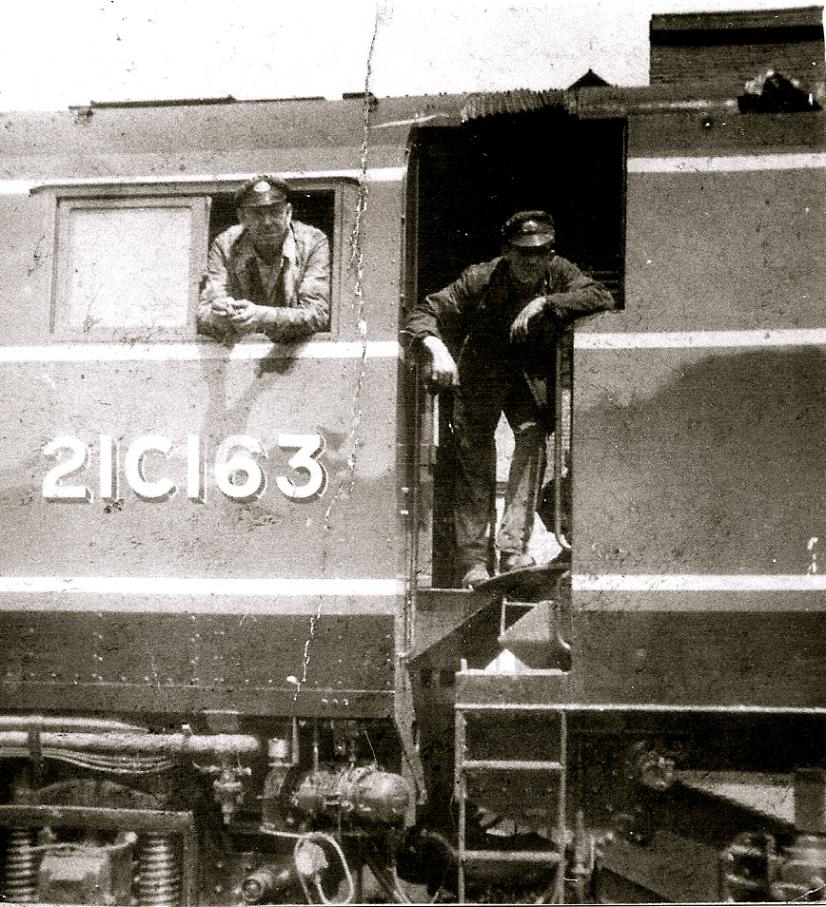
Driver Fred (Rab) Gambling & Fireman Harry Mitchell
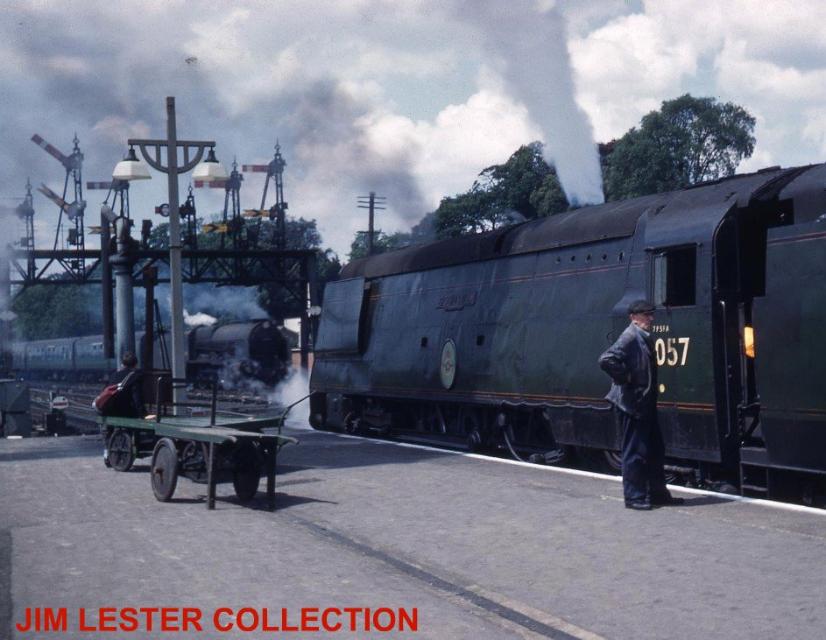
Driver Bob Cowell working a Brighton service over to Sailsbury, either bound for Plymouth or Cardiff in the late 1950's - early 1960's.
The engine is a 'Battle of Britian Class' No. 34057 'Biggin Hill' and is seen at Southampton.
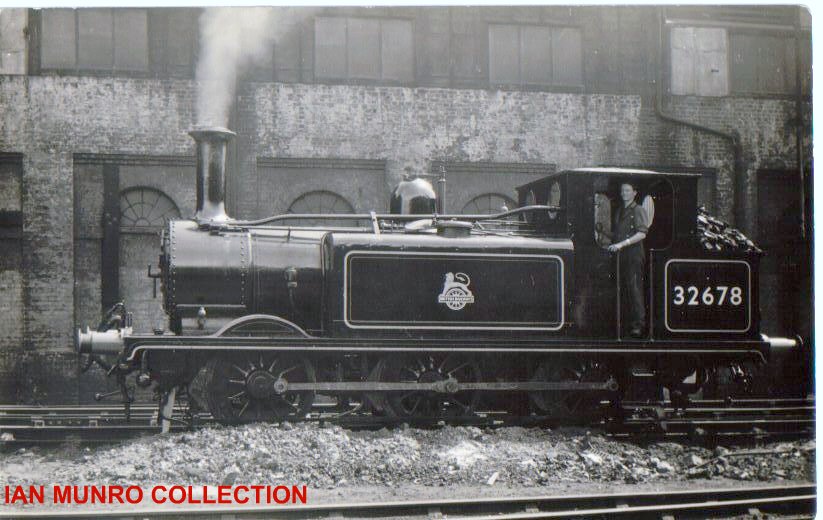
Ian Munro
Outside the Weighbridge in Brighton Loco.
Ian entered the footplate grades on the 14.08.1950 at Brighton and later transferring to Brighton E.M.U.T. in the early 1970s. On the 22nd July 1974, Ian eventually transferred to West Worthing to do a mutual change of depots with West Worthing driver Ted Janes. With the closure of West worthing in 1995, Ian transferred to Barnham where he reamained until his retirement. In July 2011 Ian emigrated to Canada.
Above shows a gallery of photos from Ian Munro's collection.
The photos features fellow Brighton Drivers & Firemen Alf Linington, Ernie Skinner, Sandy Unknown & Dave Coomber.
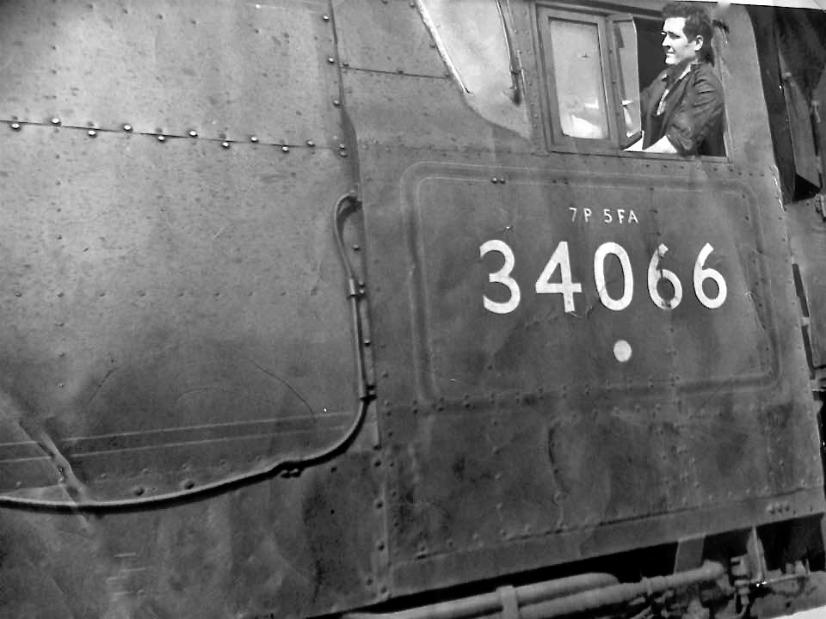
TODD SLAUGHTER COLLECTION
Robert “Todd” Slaughter
on a Battle of Britain Class locomotive “Spitfire”
Todd transferred to Brighton loco after the closure of Bognor loco in November 1961
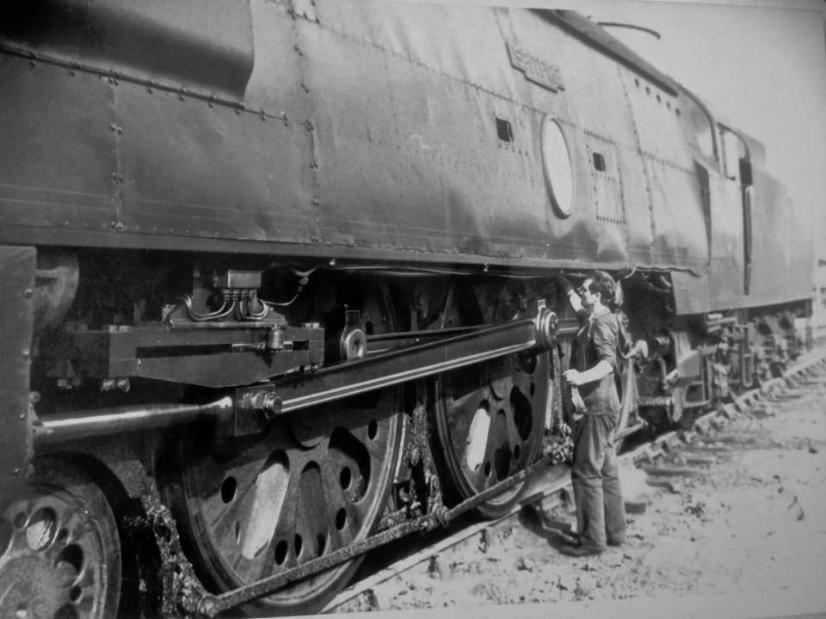
TODD SLAUGHTER COLLECTION
Robert “Todd” Slaughter
on a Battle of Britain Class locomotive “Spitfire”
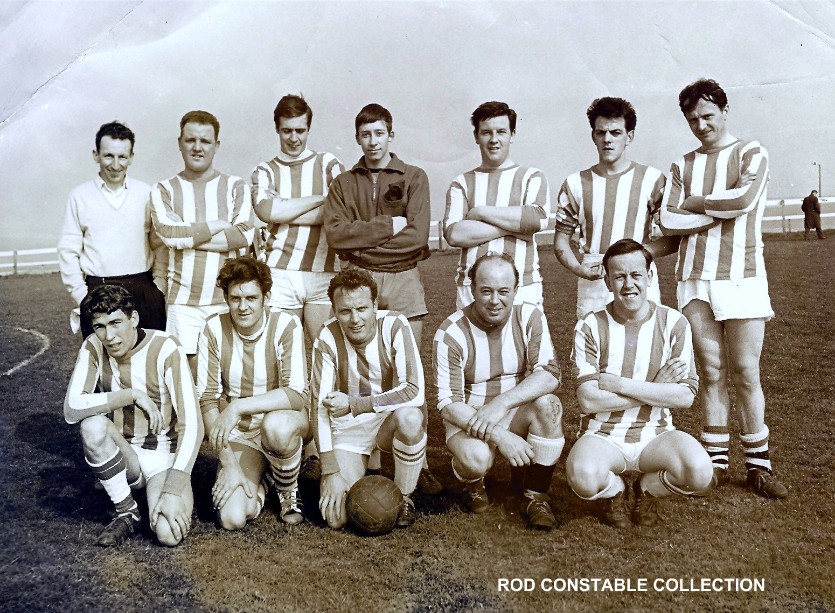
The Brighton Loco Football Team (West Side) early 1960s
Photo taken at Wrights Farm near the Race Course
Back Row Left ~ Right: Roy (Dossy) Taylor, Fred Maskell, Keith Thomas, Ron Moody, Rod Constable, Derek (Budgie) Collingham & Ian Munro
Front Row Left ~ Right: Dave Angel, Colin Taylor, Dickie Potts, Reg Jarrett & Hamish (Jock) Lockhart
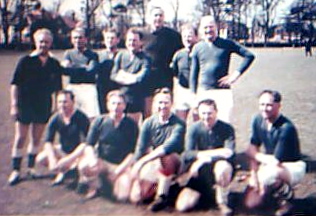
The Brighton Loco Football Team c1970s
Back Row Left - Right: Unknown 1, Unknown 2, Unknown 3, Basil House, Freddie Maskell ?, Tony Harwood, Trevor Fielding & Eddie Ricketts
Front Row Left - Right: Unknown 4, don Hutchins, George Pullen, Jimmy Southon, George Pullen & Unknown 5
Eddie Ricketts Collection
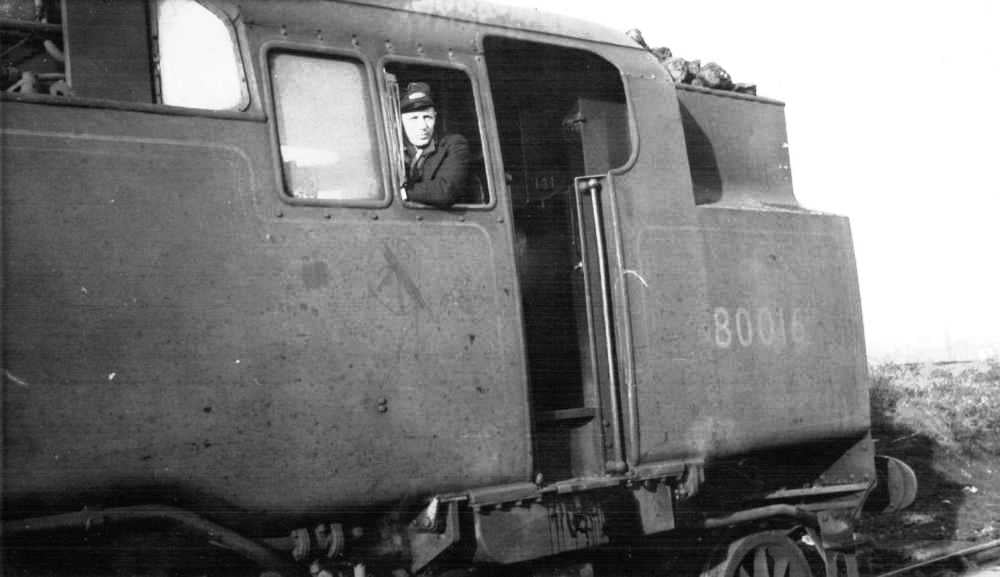
TREV SMITH COLLECTION
FRED COX
STORIES FROM THE SHOVEL
By Ian Breeds
My regular mate was Driver Harry Woolacott and Driver Bert South's regular Fireman was Spike (Bill) Jones. One day we were all in Lewes yard lobby awaiting to work our trains, when the door of the lobby opened and a guard named Eric Sargeant stood in the doorway and asked who was working the goods train to Crowborough. To which Spike replied 'me and Herb', Eric said why do you call Bert 'Herb'? Spike said ' because he is like a big fat weed'. Needless to say sparks flew between them.
All quite harmless fun though!!
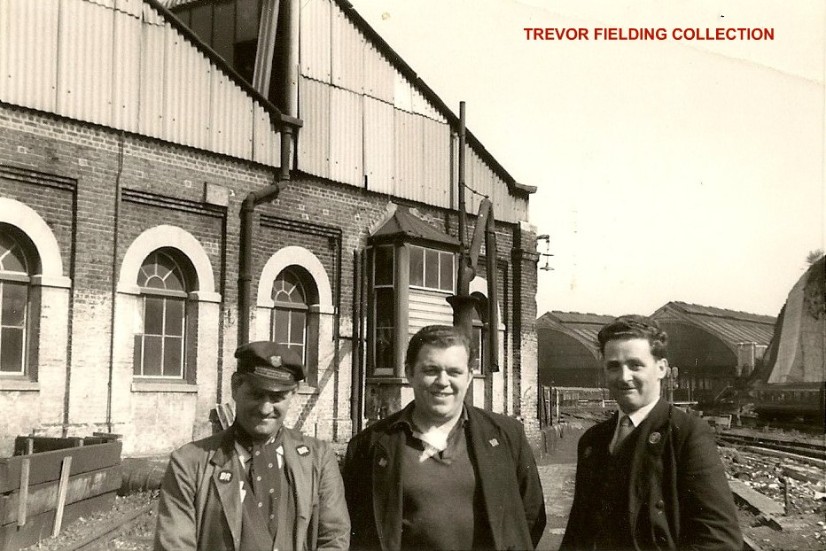
Clifford Highams, Bert South & Trevor Fielding.
Whilst working the 11.30 pm Brighton Top Yard to Norwood, we proceeded light engine from the Loco Sheds to Top Yard via the Middle Road at Brighton Station. We observed the footplate crew of the van train to London waiting at the end of platform 3. The were Driver Ernie Meeds and his Fireman Terry Parsons. We put the injector on the engine so as to facilitate the use of our spray pipe and on passing the van train engine, we sprayed into the driving compartment of the said engine.
On arrival at Norwood Loco sidings we met up with Ernie Meeds and Terry Parsons and said "for once we managed to get you soaking wet", to which they replied "no you didn't, the person who you got soaked was Driver Ernie Rogers, who was going passenger to Stewarts Lane on the van engine to start his turn of duty, and to make matters worse he was eating his supper of fish and chips."
Suffice to say he was not amused!!
Another incident Ian recalls was whilst working from Horsham to Brighton, a bucket of water flew into our cab and a glanging noise was heard, we both covered our heads until it stopped. Some time later we were met by Driver Peter Gambling who said "He was very sorry for throwing the buckett of water, but he forgot to remove the 3/4 spanner from the buckett".
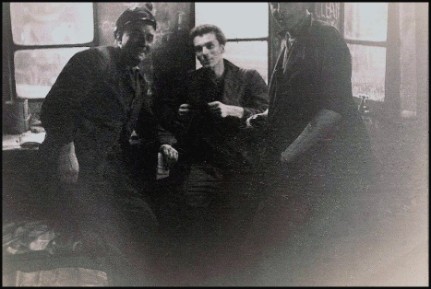
Driver Ernie Corney, Fireman Terry Parsons
& Keith Mitchell
Brighton Loco Yard Shed 1959/60
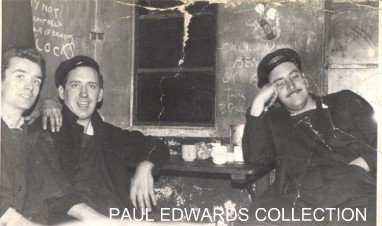
Above Left ~Right: Terry Parsons, Jimmy Edwards & Ron Sheehan
Brighton Top Yard Shunter's Lobby c1963
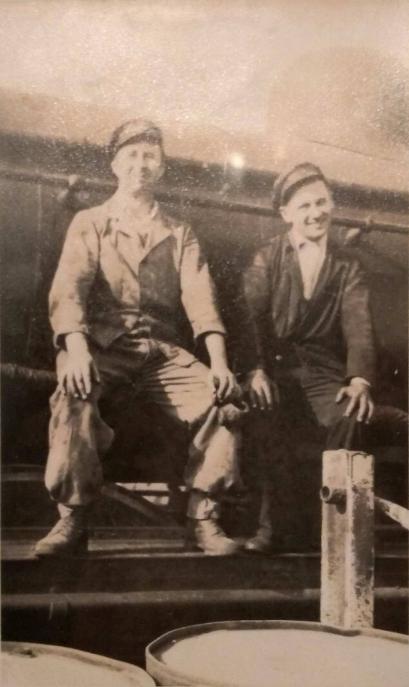
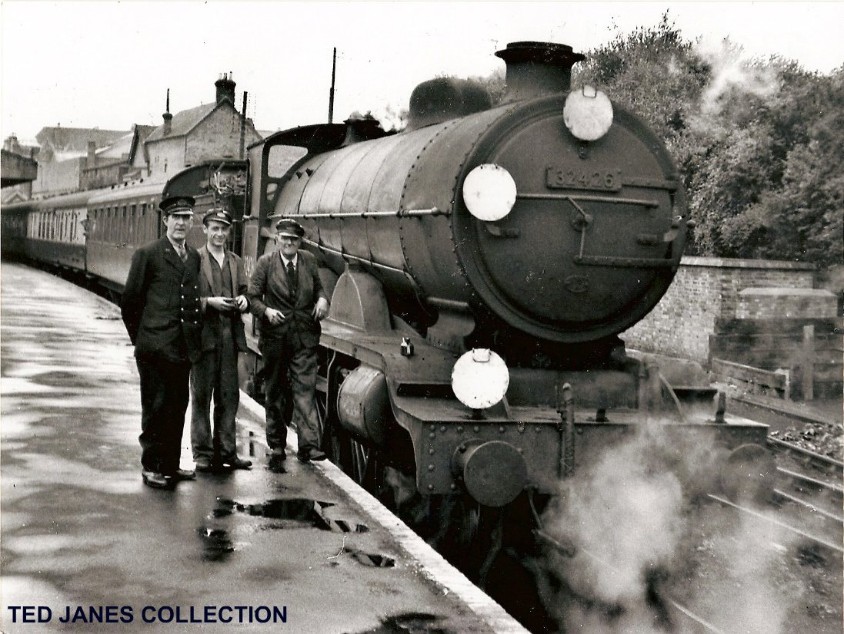
Driver Bob Roser, Fireman Ted Janes & Unknown Brighton Guard
This photo was taken by Fred Rich at Bournemouth West on the 15th August 1952
with 13:52 Bournemouth West to Brighton
Bournemouth West station is now part of thwe main road system around Bournemouth called the "Wessex Way"
The engnie was a Brighton Atlantic Class H2, 32426 'St. Albans Head'
Ted Janes recalls firing to Arthur Robert Roser for about two years in the 'Top Gang' and he was possibly Ted's longest mate and was apleasure to fire to.
Bob at the time of this photo being taken would of been about 59 years old and Ted was 24.
Bob entered the footplate grades at Brighton on the 25.06.1910.
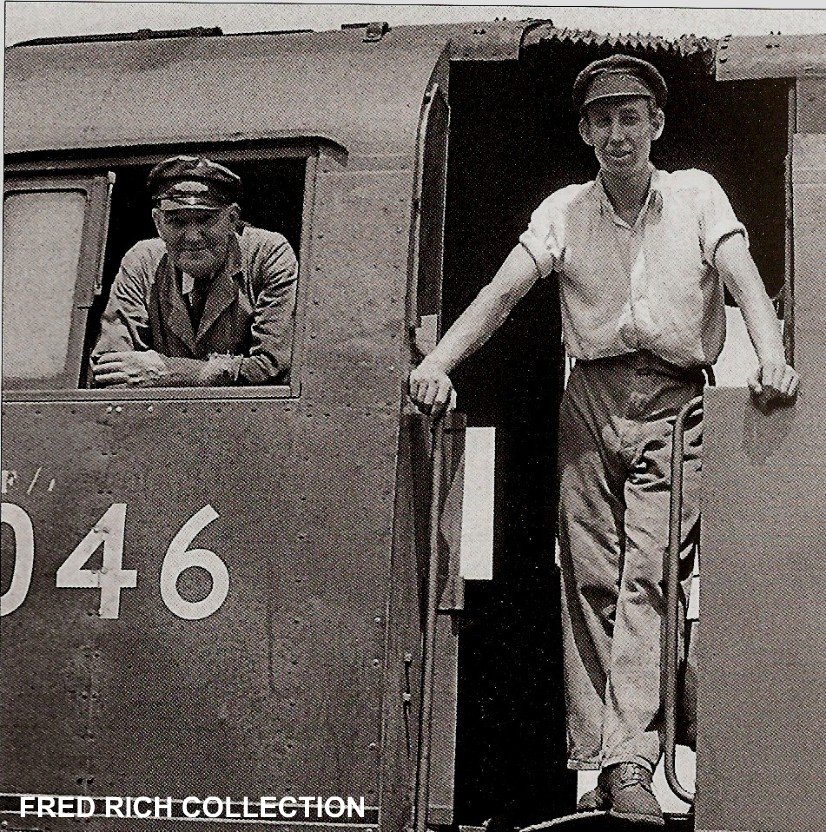
Driver Bob Roser & Fireman Reg Craft 12th July 1955 .
The small extract below recalls part of his trip on the eleven o’clock Brighton to Cardiff on Monday 11th July 1955. Brighton men used to work this train as far as Salisbury. The Brighton fireman on this trip was Reg Craft, who showed how he would cope with the firing whilst working up Dean bank. It also records the feelings of Brighton engine-men’s towards their fellow South-Western engine-men
.An extract from the Fred Rich Journals
We had no booked stops over the 24.5 miles between Southampton and Salisbury; and from Nursling [4.5 miles beyond Southampton] we began the 16 mile climb up to Bridge 44. At this point Reg initiated me into a bit of nonsense which, for him, was utterly out of character. He (along with many others from 75A) feels that most “South-Western” enginemen think too much of themselves and their railway. At Dean [about 4.75 miles from Bridge 44] the ‘eleven o’clock Cardiff’ always passes a goods engine in the sidings, with Salisbury men in charge of it; and Reg likes to show ‘em what he thinks of their Dean bank. The game is to have a ‘a potful of water’ and a full head of steam after passing through Romsey. This produces (for the benefit of those Salisbury men) the spectacle of a Brighton ‘West Country’, trailing 10 corridors, hurtling up through Dean with safety valves blowing and with the fireman relaxing in his seat, smoking a cigarette and preferably reading a newspaper.
Fred Rich worked as an engineering apprentice at Brighton Locomotive Works and commuted from Tunbridge Wells. Fred became known to a number of engine-men at Brighton. On his days off Fred would see if he could get a cab ride with the various engine-men that he knew and spent most of the trips doing some of the firing.
Driver George Washington and Fred Rich (see above)
Driver George Washington
Driver George Washington and Fireman Reg Eason
George Washington on his last working day 22.4.1960
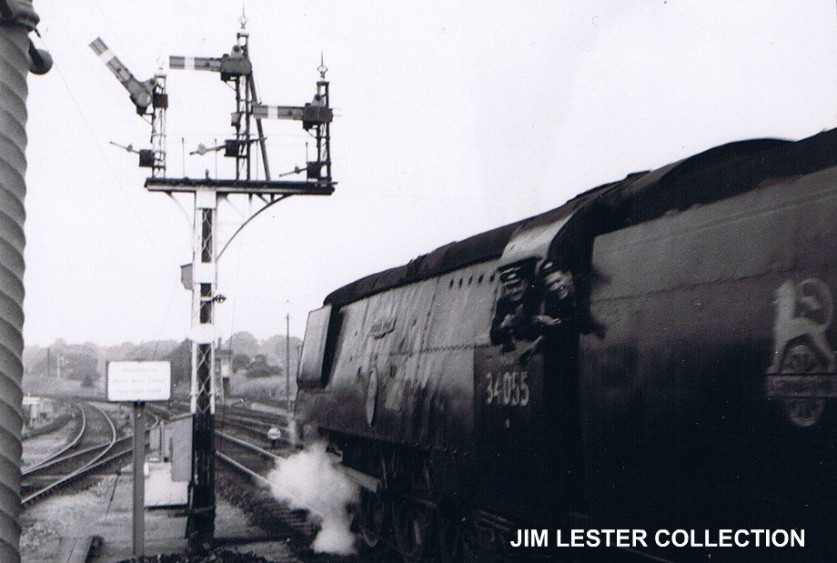
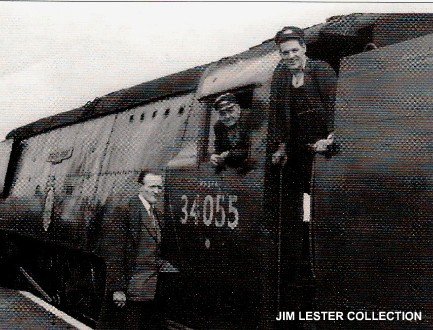
Above & Right:
Brighton's Driver Jack Rowe and his Fireman Jim Friend, who were both in the top link at Brighton at the time this photographed was taken at Fareham c1959/61.
The engine is a "Battle of Britain Class" "34055 FIGHTER PILOT"was working a Brighton service to Plymouth or Cardiff run. Brighton men worked this train as far as Salisbury. At Salisbury they would then worked a return train back from either location.
Nine Elms driver Alan Wilton stands in the foreground.
After 50 years Jim Lester (ex Nine Elms) finally found out the names of the Brighton loco who he photographed all those years ago.
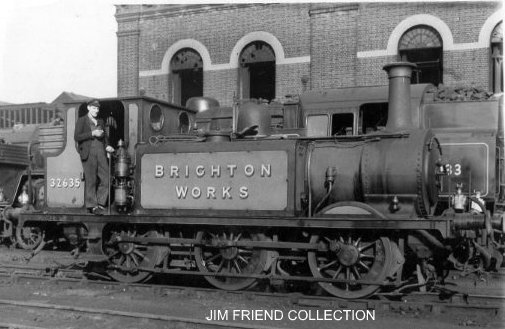
Jim Friend on the "Brighton Works" engine, a Brighton Terrier Class A1x in Brighon Loco
Jim Friend started at Brighton Loco on 16th January 1956 as a Cleaner and progressing to, Fireman and Past Fireman.
In 1963 Jim transferred to Slade Green EMUT Depot to gain his promotion to Driver. In 1965 Jim transferred to Charing Cross where remained until 20th April 1985, when Jim emigrated to Adelaide, South Australia where he now resides.
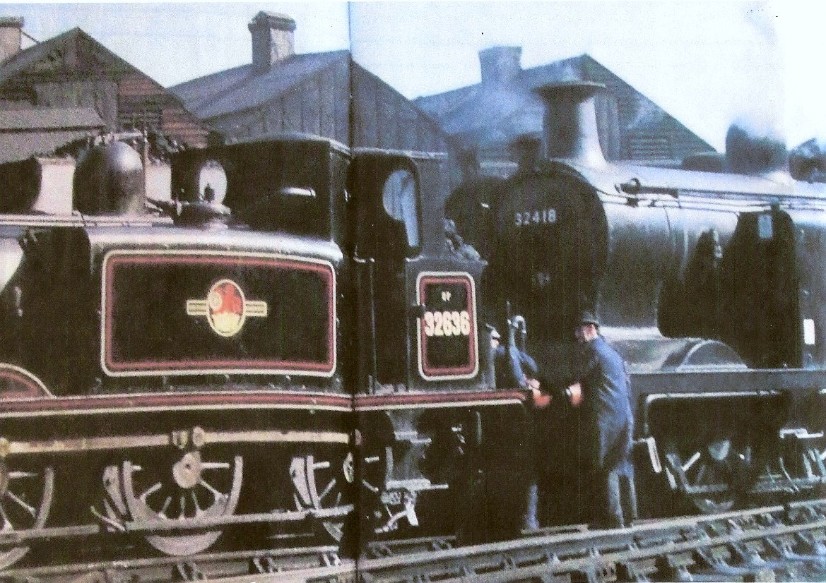
Motive Power Inspector Bill Oliver
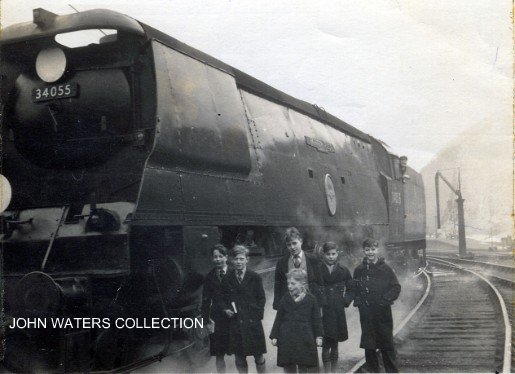
Driver Fred Maskell on the footplate of Bulleid's Light Pacific Battle Of Britian Class "Fighter Pilot" in Brighton Loco
A school boy John Waters (B'ton driver) is on the far right.
Ted Janes recalls the witnessing a Locomotive naming ceremony at Brighton Station on the 19th September 1947 when three Battle of Britains had the ceremony performed by Douglas Bader, I also remarked it was also my
Mum's birthday, her 43rd in fact.
I was certain that 34055 was one of the loco's but couldn't be sure of the other two so I went digging and found the missing links.
34053 Sir Keith Park, 34055 Fighter Pilot, & 34067 Tangmere
Of course at that date they would still have had the prefix 21C*** and Sir Douglas Bader was still only a common Squadron Leader.
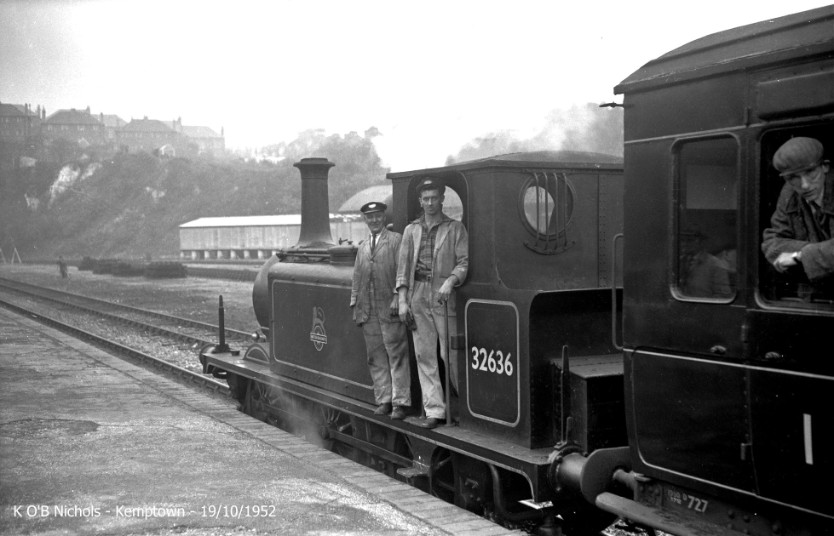
Left ~ Right Driver Frank Foord & Fireman Roy Townsend
(is this the same Roy Townsend of Eastbourne ?)
Kemp Town Station on the 19th October 1952.
Info provided about the names of the loco-men was provided by Neil Murphy, Frank Foord's Grandson
CAN ANYONE NAME THE SOUTHERN RAILWAY/BRITISH RAILWAYS FOOTPLATE MEN PHOTOGRAPHED BELOW
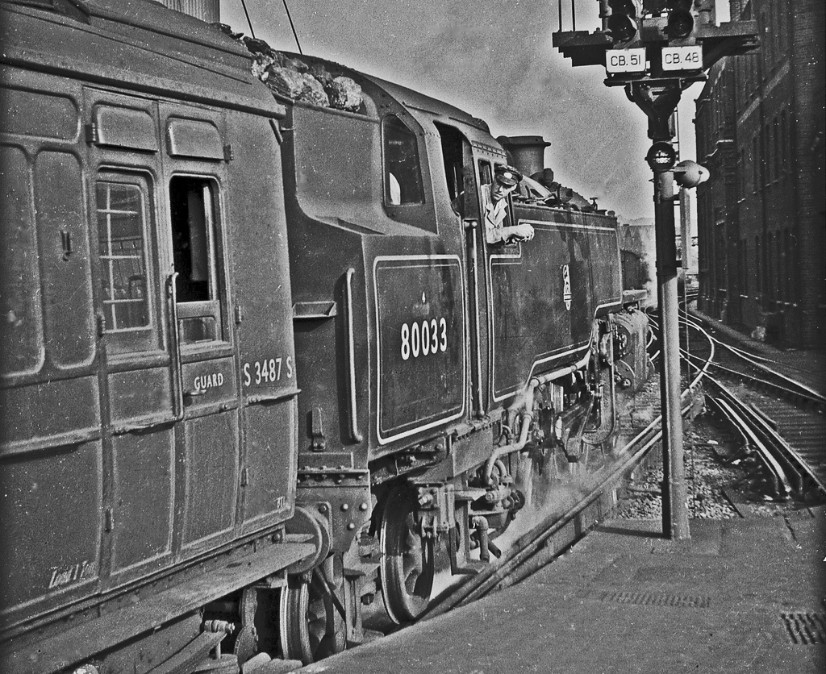
The 08:48 Brighton ~ Tunbridge Wells West on the 1st September 1955
the engine No. 80033 allocated to Brighton or TWW?
Left ~Right: Fireman Jack (John?) Fellingham & Driver Charles Pont.
STORIES FROM THE SHOVEL
Jack Fellingham was bit of a celebrity among his workmates because of the long period which he had spent exclusively on the Kemp Town service. For about twenty years, first as a fireman and then as a driver, he had done nothing else, just thousands and thousands of trips from Brighton to Kemp town and back. It might have been continued thus, but for an offical edit which said, in effect, 'You can't earn a driver's top rate unless you do main line work'. In other words if Jack wanted to take his place among the men on top rate, he would have to broaden his horizons. It was a now or never situation and it caused some amusement among his colleagues. "He'll never do it!", they told each other, "He's never been anywhere but Kemp town!"
Jack confounded them all by doing it and spent about six months 'learning the road' to London, Portsmouth, Hastings and many other routes that a top rate driver had to go.
Extracted from the book
Yesterday Once More
By Fred Rich
L~R: Fireman Jack Fellingham & Driver Charles Pont
L~R: Fireman Jack Fellingham & Driver Charles Pont
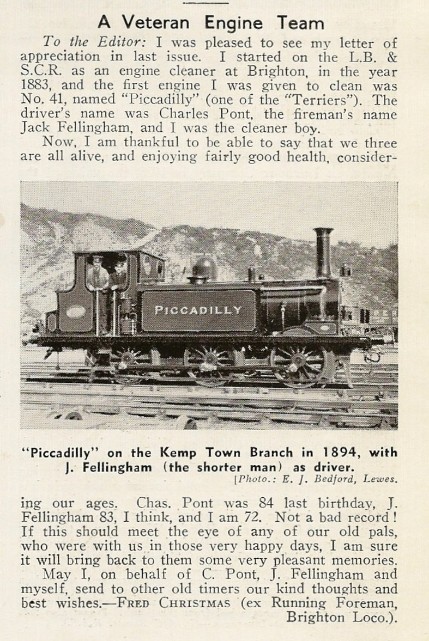
The article above was (right) taken from the Southern Railway magazine May/June 1942
Charles Pont started on the footplate sometime before 1877 and would be of similar seniority as John Fellingham.
Jack Fellingham was one of four Fellinghams that at appeared in the 1925 Southern Railway Seniority Book, their seniority dates are
John/Jack William Harris Fellingham started in May 1877,
John/Jack William Fellingham (Jun) started at Brighton in 8th September 1903
John/Jack later transferred to Brighton’s motorman’s depot in late 1935, (slightly prior to September and probably in the June July time in connection with the electrification of the lines to Seaford/Eastbourne/Ore)1935 where he remained until his retirement in 1950).
The Census return of the 1911 for 27 Claremount Street has the head as widowed John William Harris Fellingham, engine driver (Railway) aged 50 as the head with 24 year old son John William Fellingham (Fireman crossed out) Engine Stoker (Railway) living there as well as daughter Maude aged 20.
Sid Fellingham started on 16th August 1909 transferred to the motorman’s depot in late 1937 until March/Arpil 1949.
The Census return of the 1911s stating that Sydney Fellingham a 20 year old engine cleaner living at 2 Boss’s Gardens, a different family to the John/Jack family and maybe cousins
E. Fellingham started on the 1st February 1916
I was wondering if these loco men they are all connected and if there are any Fellinghams living in the Brighton area
Driver Henry Lewry & Fireman William Sands
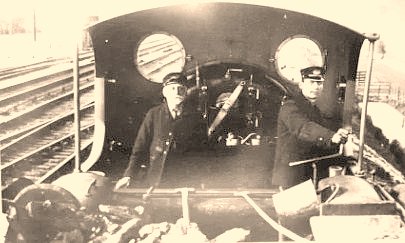
Driver Alf Alwyn on his Gladstone Class locomotive at Lewes East Yard
William Love is seen standing on the Brighton loco turntable
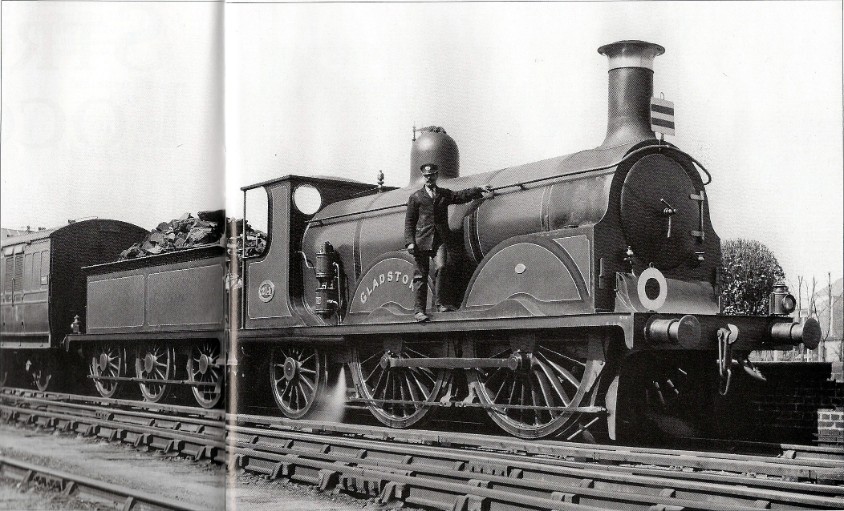
William Love
William Love in 1877 is listed as a Engine driver at the age of 39, was to be the first Engine driver of engine B1 class No. 214 Gladstone, which is now preserved in the N.R.M. at York by the "Stephenson locomotive Society", with his name immortalised in the cabin in the L.B.S.C.R. tradition.
No. 214 Gladstone entered service in 1882 and was withdrawn from service in December 1926, the engine ran 1,346918
William Love was William Stroudley's (Brighton's Locomotive Superintendent 1870-89) senior driver who accompanied Stroudley 's last prize winner, "B1 class No.189 Edward Blount" to Paris in 1889.
(William Stroudley died whilst attending the Paris Exhibition of 1889)
William Love used to tell the story, that whilst standing by his engine waiting to be signaled to his train, when Stroudley come along and asked: "How is it Love, that you always run through Haywards Heath without taking water?" Love replied "that he always started off with a cold tender." Stroudley paused for a moment, struck his umbrella on the footplate, and exclaimed "Of course, I didn't think of that! You do not expand your water by heating it!"
It was a custom of drivers to heat their water by knocking the steam back into the tender, consequently they did not start off with so much water owing to it being expanded by heating it.
extracted from an article by A.G.Ewens
that appeared in the Southern Railway magazine
March/April 1942
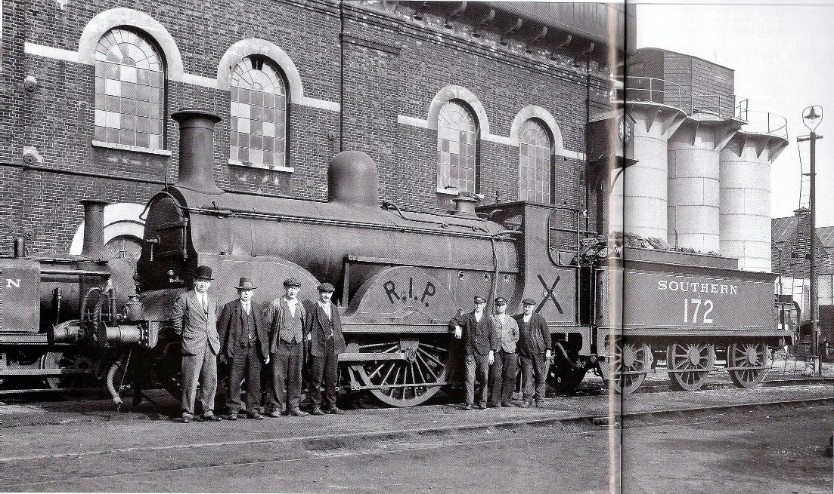
The photo features Brighton Shed staff and the footplatemen who worked on the Loco.
This was the last of the B1 class "No172 Littlehampton" to be withdrawn from service at Brighton in September 1933.
CAN ANYONE NAME THE L.B.&S.C. Rly FOOTPLATE MEN PHOTOGRAPHED BELOW
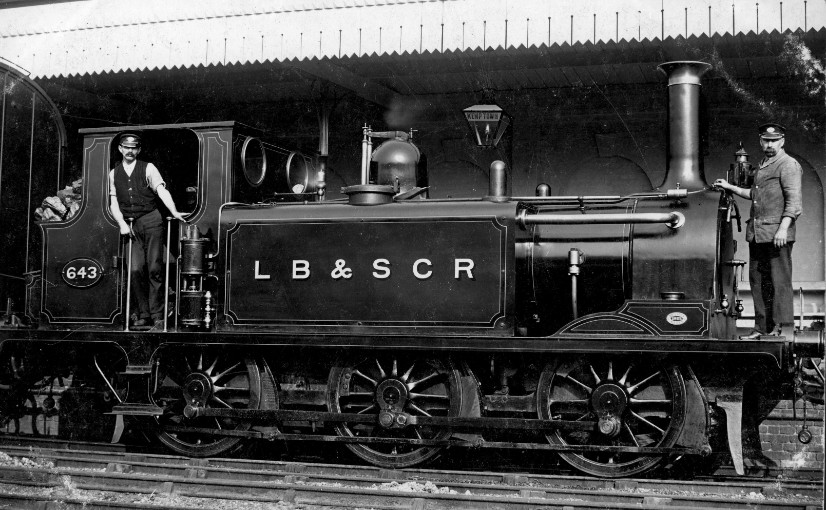
Photo taken at Kemp Town some time after 1877 "Gypsy Hill"
Above are a number of photos of L.B.S.C.R. loco-men with their allocated locomotives.
Up until c1919 engine drivers on the L.B.S.C.R. were allocted a locomotive, I am therefore hoping that someone may have a list of locomotives and the engine men that were allocted to work on them over the years.
Driver Israel Clark with his Fireman and their engine No. 43 Duchess of Fife at Three Bridges in 1910
In the 1991 Census Israel Clark lived Ashford Road Eastbourne.
Driver Packham with his Fireman and their engine No. 47 Canada at Haywards Heath in 1910
The Scotsman locomotive No 43, which when rebuilt became 2043, and she was unique in being the only one of the breed not to be Westinghouse fitted, having just the vacuum and a steam brake. The rebuilds had a drop grate, a luxury in those day and were easy to dispose of, 44 and 51 remained as built and 44 was at Brighton and when I was in the top link with “Daisy” Brooker ( Reg’s Uncle Alf”) she was the regular engine for the 5-44 pm Tonbridge and 9-30 return.
Info kindly provided by
retired Brighton Driver Ted Janes
THE BRIGHTON MOTIVE POWER DEPOTS WEBSITE.
HAS NOW BEEN MOVED TO A NEW SITE CALLED
IGNITING THE FLAMING OF UNITY
https://ignitingtheflameofunity.yolasite.com/
PLEASE CLICK ON THE IMAGE BELOW
TO TRANSFER TO THIS NEW SITE
CLICK ON THE ABOVE IMAGE TO TAKE YOU
TO THE NEW UPDATED COMBINED AND WEBSITE
IGNITING THE FLAME OF UNITY WEBSITE
https://ignitingtheflameofunity.yolasite.com/
THIS WEBSITE COMBINES THE FOLLOWING WEBSITES
THE BRIGHTON A.S.L.E.&F., THE BRIGHTON MOTIVE POWER DEPOTS
& THE SUSSEX MOTIVE POWER WEBSITES
WHICH EXPLAINS THE EVOLUTION OF THE FOOTPLATE GRADES AND THE
HISTORY OF THEIR TRADE UNIONS AND THE STRUGGLES TO IMPROVE
THEIR WORKING LIVES
CLICK ON THE ABOVE IMAGE TO TAKE YOU
TO THE NEW UPDATED COMBINED AND WEBSITE
IGNITING THE FLAME OF UNITY WEBSITE
https://ignitingtheflameofunity.yolasite.com/
THIS WEBSITE COMBINES THE FOLLOWING WEBSITES
THE BRIGHTON A.S.L.E.&F., THE BRIGHTON MOTIVE POWER DEPOTS
& THE SUSSEX MOTIVE POWER WEBSITES
WHICH EXPLAINS THE EVOLUTION OF THE FOOTPLATE GRADES AND THE
HISTORY OF THEIR TRADE UNIONS AND THE STRUGGLES TO IMPROVE
THEIR WORKING LIVES
Are the loco men above based at Brighton?

